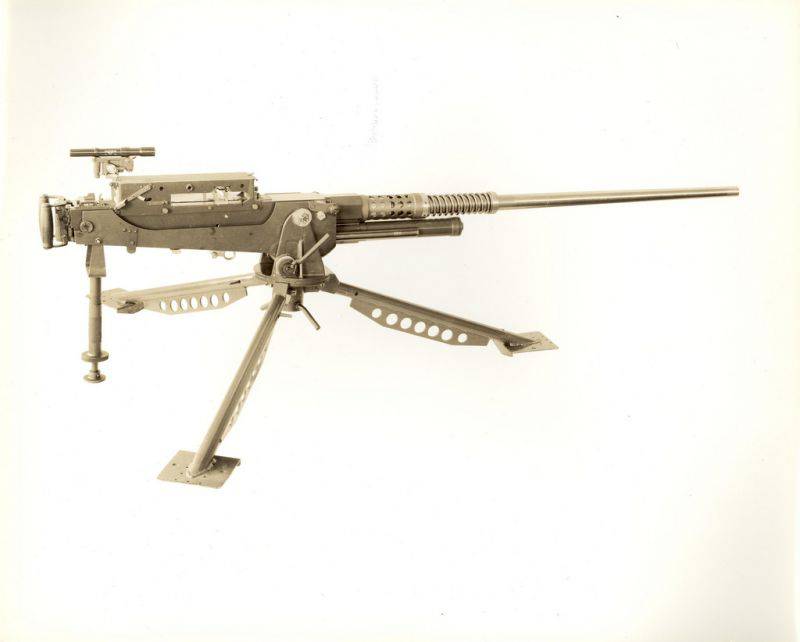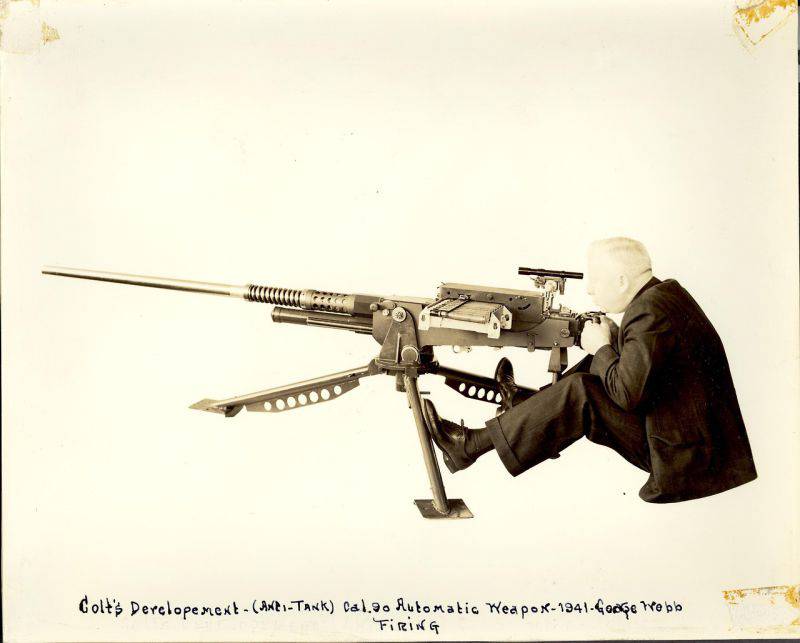Automatic anti-tank 23-mm gun Colt Т4 (prototype)
The basis for the Colt T4 automatic anti-tank gun was the 37 mm Browning automatic gun, which had a long barrel travel. Together with the gun, the cartridges 23x139SR were to be used, the supply of which was carried out on the left or on the right from the cage. It was assumed that such a gun would be enough to deal with lightly armored targets. It should also have been quite effective against Japanese tanks, which did not differ in special booking. The small armor effect of 23-mm ammunition was planned to be compensated by a large number of them fired at the target. With a rate of fire of 800 m / s and the presence of 10-round clips, one could count on the fact that all the shells would be fired at one target.
History create
In the 1930s, when all the states of Europe showed their interest in the development of aviation cannon weapons, the US Army Ordnance Department also began work in this direction. The decision was immediately made to combine the efforts of the Air Corps and the Munitions Department. The caliber of the artillery system was determined as 0,9 inches. In the metric system, the diameter of the bore was supposed to be 22,86 mm, but in the literature its part is designated as 23 mm according to the diameter of the projectiles used. The reason for choosing this particular caliber is not fully understood. Most likely, the Americans simply decided to increase the power by increasing the caliber of weapons and surpass foreign analogues of the 20 mm caliber. There is also a possibility that the 23 mm caliber was borrowed from the Danish-made Madsen gun, which was being tested in the United States in those years.

In March 1937, the desired characteristics of the automatic cannon were listed in the technical specifications. In particular, the initial speed was determined at the level of 869 m / s, and the rate of fire was supposed to be just 130 shots / min. The requirement of such a low rate of fire is also not very clear, since in the same years, the air cannons of European manufacturers provided 2,5-3 times the rate of fire. The mass of the gun should not exceed 57 kg. In addition, the power supply system was specified - shop on 50 shells weighing 9 kg (empty) and 15,5 kg (full). The army arsenal of Waterlvit, the artillery arsenal in Rock Island, were brought to work on the aviation cannon, and a large Colt corporation joined the work a little later.
The first type of air gun, designated T1, was created by the Rock Island Arsenal. This sample turned out to be too bulky. The T1 gun used a flat drum for 50 rounds, and the curb weight of the gun exceeded 93 kg. The automatics of the gun worked due to the long recoil of the barrel, the excess of the resulting recoil energy was absorbed using a spring with an oil-hydraulic buffer. The gun barrel was air-cooled. The rate of fire of the gun was approximately 150 rds / min, while it could be adjusted using a valve in the buffer, which controlled the passage of oil in the hydraulic system. For this airgun, a specially modified cartridge was used for the 28-mm naval anti-aircraft gun 1.1 "/75 M1 and M 2, better known as the "Chicago Piano". The regular 28x199SR cartridge for this anti-aircraft gun was simply compressed the neck to 23 mm and reduced the length of the sleeve. The new cartridge was designated 23x146SR and proved to be very powerful.
Inconvenient and unsuccessful ammunition supply system. The T1 aircraft gun used a hydraulic charging mechanism. The magazine weighing 36 kg was fixed on the top of the receiver, it was driven by hydraulics. Small magazine capacity, low rate of fire, as well as a number of other less obvious features left the new gun an outsider compared to existing foreign competitors. At the same time, the gun was made of metal and tested in January 1938 with very disappointing results.
Due to the long recoil stroke, the cycle was very slow, and this led to a very low rate of fire. As a result, American designers managed to create a less powerful and lightweight version of the Chicago Piano. The only positive thing was the high initial velocity of a very powerful projectile for the aviation system, reaching the 890 m / s. The result of the development of the T1 cannon was the realization that such high power was not needed for the aviation system, but the rate of fire was deemed insufficient. As a result, the specification has been adjusted. The initial speed requirements were reduced to 823 m / s, and the rate of fire to 500 shots / min.
Under these adjusted requirements, several more samples of aircraft guns were created at the Watervliet arsenal, which received the designation T2 and T3. Of greatest interest was the project of the 23-mm American automatic gun, created by the Colt Corporation and having the T4 index. Its development began in 1940, by that time the Second World War in Europe was already in full swing.
The basis for the development of the T4 was the 37-mm Browning M1A1 anti-aircraft gun, which worked on the basis of a long barrel recoil. At the same time, the 23x139SR cartridge was simply borrowed from the T3 gun. Power could be supplied both from the left side and from the right side using flat 10-round clips, which were later planned to be replaced with a closed magazine. Apparently, it should have been similar to that used on the 37 mm M4 guns.
The mass of the T4 gun without a magazine was approximately 92 kg. Its rate of fire reached 800 rds / min. However, at the moment when this gun was being tested in March 1941, the introduction of the 20-mm French-made HS.404 air gun was already in full swing in the United States, so it was decided to abandon the launch of the T4 in a series. At the same time, the high-speed and fairly reliable design of the Colt T4, which at the same time has great power, did not go unnoticed. It was decided to adapt this automatic gun to combat armored vehicles. The gun was mounted on a special tripod and tested as a mobile anti-tank infantry weapon, but the army command was not interested in it in this capacity either.
Unfortunately, today it is difficult to find data on the armor penetration of this artillery system, and the mass of the shells used is also unknown. The gun was supposed to fit into the niche between machine guns and anti-tank rifles caliber 12,7-mm and anti-tank guns. At the same time, ideally, the military expected to receive anti-tank weapons that two soldiers or one horse could carry. However, the weight in 92 kg without a store did not make the artillery system more transportable. On tests in the spring of 1940, the US military compared the T4 with the Swiss 20-mm PTR Solothurn S.18 / 1000. They concluded that the American design outperformed its rival in armor penetration, but found the weapon too cumbersome and difficult to use in the army.
Information sources:
http://www.airwar.ru/weapon/guns/t1.html
http://gunm.ru
http://strangernn.livejournal.com
http://popgun.ru


Information